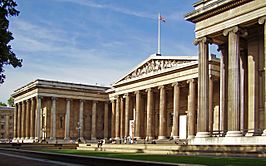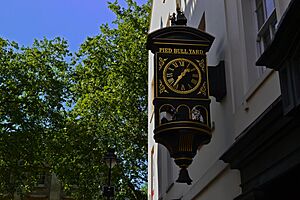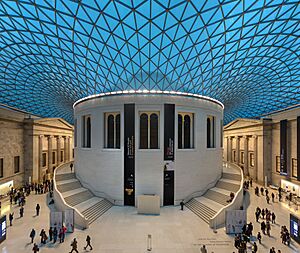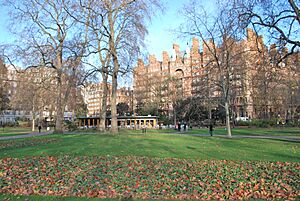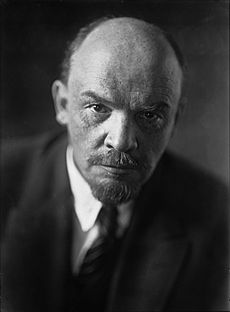Bloomsbury facts for kids
Quick facts for kids Bloomsbury |
|
|---|---|
|
Top to right: British Museum; Bedford Square, Cartwright Gardens; Sicilian Avenue; Gordon Square
|
|
| Population | 10,892 (2011 Census. Ward) |
| OS grid reference | TQ299818 |
| London borough | |
| Ceremonial county | Greater London |
| Region | |
| Country | England |
| Sovereign state | United Kingdom |
| Post town | LONDON |
| Postcode district | WC1, NW1 |
| Dialling code | 020 |
| Police | Metropolitan |
| Fire | London |
| Ambulance | London |
| EU Parliament | London |
| UK Parliament |
|
| London Assembly |
|
Bloomsbury is a cool area in the West End of London, part of the London Borough of Camden in England. It's known as a stylish place to live. It's also home to many important places for culture, learning, and education.
Bloomsbury is where you'll find the British Museum, which is the biggest museum in the United Kingdom! It also has lots of schools and universities. These include University College London and many other parts of the University of London. You can also find the Royal Academy of Dramatic Art here, where actors learn their craft.
Bloomsbury is a big center for ideas and books in London. It's home to Bloomsbury Publishing, the company that publishes the Harry Potter books! The area also gave its name to the Bloomsbury Group. This was a famous group of British thinkers and artists. They included the writer Virginia Woolf and the economist John Maynard Keynes.
Bloomsbury started to grow in the 1600s. But it really became the fancy area we know today in the 1800s. This was thanks to the Duke of Bedford and a famous builder named James Burton. The area is famous for its many beautiful garden squares, like Bloomsbury Square, Russell Square, and Bedford Square.
Today, Bloomsbury's old buildings are protected. There's a special plan to make sure new buildings fit in. However, some people worry that new, very large buildings might change the area too much.
Contents
What is Bloomsbury's History?

Bloomsbury has a long history. It has always been closely linked to the nearby area of Holborn.
How Bloomsbury Got Its Name
The name Bloomsbury first appeared in records in 1281 as Blemondisberi. It was named after the Blemund family, who owned the land back then. Their name came from a place in France called Blemont.
At first, Bloomsbury was mostly countryside. In the 1300s, Edward III took the land. He then gave it to a group of monks.
In the 1500s, during the time of King Henry VIII, the land went back to the Crown. Henry VIII then gave it to Thomas Wriothesley, 1st Earl of Southampton.
How Bloomsbury Was Governed

Bloomsbury was part of a larger area called the Ancient Parish of St Giles. This area was looked after by the church of St Giles in the Fields. Over time, these parishes took on more jobs, like helping the poor.
In 1731, a small new parish called Bloomsbury was created. But in 1774, these areas joined back together for local government.
Later, in 1900, Bloomsbury became part of a new area called the Metropolitan Borough of Holborn. Then, in 1965, this borough joined with other areas to form the new London Borough of Camden.
Bloomsbury's Borders
Bloomsbury's old borders are along Tottenham Court Road to the west. To the north, it's around Torrington Place. To the east, it's near Marchmont Street and Southampton Row. The southern border is close to High Holborn.
Sometimes, people think Bloomsbury is just the land owned by the Bedford Estate. But the actual area is a bit different.
How Bloomsbury Was Built Up
In the 1660s, the Earl of Southampton started building what became Bloomsbury Square. The land then passed to the Russell family. This happened when William Russell, Lord Russell married Rachel Wriothesley, who owned Bloomsbury.
The area was mostly planned and built in the 1700s. Wriothesley Russell, 3rd Duke of Bedford, opened Bloomsbury Market in 1730. Later, his wife helped build Bedford Square and Gower Street.
The famous squares you see today really started to be built around 1800. Francis Russell, 5th Duke of Bedford, developed the land to the north, with Russell Square as a main feature. Much of this land is still owned by the Bedford Estate today.
In the 1800s, Bloomsbury became a popular place for writers, artists, and musicians. It was also good for lawyers because of the nearby courts. Over time, the area became less about fashion and more about learning. The University of London and the British Museum grew here, along with many hospitals.
The London Beer Flood
The London Beer Flood was a strange event that happened in October 1814. A huge barrel of beer at the Horse Shoe Brewery burst open. This sent a 15-foot wave of beer into the streets! Sadly, eight people died in this unusual accident.
Protecting Bloomsbury's Heritage
All of Bloomsbury is part of the Bloomsbury Conservation Area. This is a special historical area that helps protect old buildings and limit new construction. It was set up in 1968.
Bloomsbury also has a special group called the Bloomsbury Conservation Area Advisory Committee (BCAAC). This group is made up of experts like architects and planners who live in Bloomsbury. They know a lot about the area's history and buildings. They advise on new building plans to make sure Bloomsbury keeps its special look.
Bloomsbury has many listed buildings, which are very important historical buildings. The British Museum is one of them. However, because Bloomsbury is in the center of London, there's a lot of pressure to build new things. Some people worry that too many new, tall buildings are being built. This has led to some old Victorian and Georgian buildings being torn down. Groups like the Victorian Society and Georgian Group are working to protect Bloomsbury's history.
Nearby Places
Bloomsbury is surrounded by other interesting parts of London. These include St Pancras to the north, Fitzrovia to the west, Covent Garden and Holborn to the south, and Clerkenwell to the east.
 |
Regent's Park | Somers Town | St Pancras |  |
| Fitzrovia | Clerkenwell | |||
| Soho | Covent Garden | Holborn |
Culture and Learning
Bloomsbury has always been linked to art, education, and medicine.
The area is famous for the Bloomsbury Group. This was a group of artists and writers, including Virginia Woolf, who met in homes here in the early 1900s. The publisher Faber & Faber used to be in Queen Square. The Pre-Raphaelite Brotherhood, a group of artists, started in a house on Gower Street in 1848.
The Bloomsbury Festival started in 2006. It's a free festival that celebrates the local area. It works with galleries, libraries, and museums.
Schools and Universities

Bloomsbury is a major center for education. It's home to the main offices and library of the University of London. Many of its colleges are also here, such as Birkbeck College, London School of Hygiene and Tropical Medicine, and University College London.
Other schools in Bloomsbury include the London Contemporary Dance School and the Royal Academy of Dramatic Art. Many American universities also have campuses here, like New York University.
Museums to Explore
The British Museum is a must-see in Bloomsbury. It first opened to the public in 1759. Inside, the Queen Elizabeth II Great Court is a huge indoor space with a glass roof. It has displays, a cinema, shops, and places to eat. The British Library, which used to be part of the museum, is now in a separate building nearby.
You can also visit the Foundling Museum near Brunswick Square. It tells the story of the Foundling Hospital. This hospital was opened by Thomas Coram to help children in Georgian London. The hospital buildings are gone, but the area is now Coram's Fields, a playground and sports field for kids. It even has a few sheep!
The Dickens Museum is on Doughty Street. It's where the famous writer Charles Dickens lived. You can also find the Petrie Museum of Egyptian Archaeology and the Grant Museum of Zoology at University College London. The Postal Museum is also in Bloomsbury.
Churches in Bloomsbury
Bloomsbury has several interesting churches:
- St. George's Church, Bloomsbury: This is Bloomsbury's main church. It was built between 1716 and 1731. It has a grand entrance with huge columns and a unique tower with a statue of King George I on top.
- St Giles in the Fields: Also known as the Poet's Church, this building was built in 1733.
- Church of Christ the King, Bloomsbury: This church on Gordon Square was built in 1853. It's a beautiful old building.
- St Pancras New Church: Near Euston station, this church was finished in 1822. It's known for its statues of women that act as columns.
- St George the Martyr Holborn: In Queen Square, this church was built in the early 1700s. It's where writers Ted Hughes and Sylvia Plath got married.
- Bloomsbury Central Baptist Church: This church on Shaftesbury Avenue opened in 1848.
Parks and Squares
Bloomsbury is famous for its many beautiful garden squares. These include:
- Russell Square: A large, well-kept square with gardens designed by Humphry Repton. The Underground station is nearby.
- Bedford Square: Built between 1775 and 1783, it still has its original Georgian houses.
- Bloomsbury Square: Features a small circular garden.
- Queen Square: Home to the National Hospital for Neurology and Neurosurgery.
- Gordon Square: Surrounded by university buildings and former homes of famous people like Virginia Woolf and John Maynard Keynes. This is where the Bloomsbury Group met.
- Woburn Square: Also home to parts of University College London.
- Torrington Square: Another square with university buildings.
- Tavistock Square: Home to the British Medical Association.
- Mecklenburgh Square: One of the few squares that is still private for local residents.
- Coram's Fields: A large play area for children, where the Foundling Hospital used to be. Only children and adults with children can enter.
- Brunswick Square: Now home to the School of Pharmacy and the Foundling Museum.
- St George's Gardens: An old burial ground that is now a peaceful garden.
- Cartwright Gardens.
Hospitals
Bloomsbury has several important hospitals. These include Great Ormond Street Hospital for Children and the National Hospital for Neurology and Neurosurgery on Queen Square. University College Hospital is also in Bloomsbury, with new buildings opened in 2005. The Eastman Dental Hospital is nearby.
Other Interesting Buildings
One of the biggest buildings in the area is the Brunswick Centre. It's a unique residential building with shops on the ground floor.
Getting Around Bloomsbury
Train and Underground
Bloomsbury is well connected by public transport. There are several London Underground stations:
- Russell Square

- King's Cross St. Pancras






- Euston Square



- Goodge Street

King's Cross St. Pancras station has step-free access, which means it's easy to use if you have a buggy or wheelchair. Other nearby stations include Euston and Tottenham Court Road. There's even a disused Underground station called British Museum.
Three major train stations are just north of Bloomsbury:
From St Pancras, you can even catch the Eurostar train to France, Belgium, and the Netherlands!
Buses
Many bus stops are in Bloomsbury. Buses here can take you to popular places like Camden Town, Piccadilly Circus, and Waterloo.
Cycling
Bloomsbury has several cycle routes. These include special cycle tracks or bus lanes that cyclists can use. You can cycle from Bloomsbury to places like Covent Garden and King's Cross on routes like Quietway 1.
Famous People from Bloomsbury
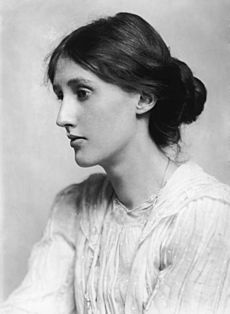
Many famous people have lived in Bloomsbury:
- J. M. Barrie (1860–1937): The writer who created Peter Pan lived here. He even set the Darlings' house in Bloomsbury!
- Vanessa Bell (1879–1961): A painter and sister of Virginia Woolf, she lived on Gordon Square.
- Charles Darwin (1809–1882): The famous scientist lived on Gower Street in 1839.
- Charles Dickens (1812–1870): The well-known novelist lived in several places in Bloomsbury, including Doughty Street.
- E. M. Forster (1879–1970): A novelist and essayist, he lived in Brunswick Square.
- Ricky Gervais (born 1961): The comedian used to live in Bloomsbury.
- John Maynard Keynes (1883–1946): A very important economist, he lived on Gordon Square for 30 years.
- Vladimir Lenin (1870–1924): The founder of the Soviet Union lived here in 1908.
- Bob Marley (1945–1981): The famous musician lived in Ridgmount Gardens for six months in 1972.
- Catherine Tate (born 1968): The actress and comedian grew up in the Brunswick Centre.
- Kenneth Williams (1926–1988): The actor and comedian lived on Marchment Street.
- Virginia Woolf (1882–1941): A very important author, she lived on Gordon Square and Tavistock Square.
- William Butler Yeats (1865–1939): The poet lived on Woburn Walk.
Images for kids
See also
 In Spanish: Bloomsbury para niños
In Spanish: Bloomsbury para niños


